ISSN ONLINE(2319-8753)PRINT(2347-6710)
ISSN ONLINE(2319-8753)PRINT(2347-6710)
V. R. Murugananthan1, K. Govindaraj2, D.Sakthimurugan3
|
| Related article at Pubmed, Scholar Google |
Visit for more related articles at International Journal of Innovative Research in Science, Engineering and Technology
A value stream is all the actions (both value added and non-value added) required to bring a product through the main flows essential to every product for the production flow from raw materials into the arms of the customer and to design the flow from concept to launch as a lean manufacturing tool. Taking a value stream perspective means working on the big picture, not just individual processes and improving the whole not just optimizing the parts. In this paper, in a casting foundry with results are considered with current state maps and future state maps after following the different steps starting from the detailed time study for mapping the processes from raw materials to final product. When we engage in true process improvement, we seek to learn what causes things to happen in a process and to use this knowledge to reduce variation, remove activities that contribute no value to the product or service produced, and improve customer satisfaction. Process improvement means examine all of the factors affecting the process, the materials used in the process, the methods and machines used the transform the materials into a product or service, and the people who perform the work. Lean production starts from the arguments that adding value and reducing waste. Value stream mapping is different than conventional recording techniques, as it captures the information at individuals stations about station cycle time, uptime or utilization of resources, setup time, WIP inventory, manpower requirement and the information flow from raw materials to finished goods. This paper details the use of the value stream mapping in reducing waste in manufacturing company. With a case study in a one of the casting industry, the production process path is visualized by mapping the current state value stream map. After tracking the entire process, wastage affecting the cycle time are identified and its causes analyzed. A future state value stream map is developed and improvement ideas are suggested. Value stream mapping is proved as a useful technique to minimize the cycle time and increase the productivity.
Keywords |
| Lean manufacturing, 5S, Value Stream mapping. |
INTRODUCTION |
| Casting Industry is Located in Coimbatore, India and have been dominant player in the manufacturer of Horn end other products like Castings and Industrial Cleaning Machines. Since its establishment in 1970, Company had a vision and commitment to produce and deliver products adhering to International standards.Casting Industry, a multifaceted industrial conglomerate in this part of the country with a tradition, for over three decades of the excellence in automobile parts, industrial products and engineering that values and believes in the power of people much more than technology. It is a company that is built on the principles of ethics and human values on a solid footing. Its commitment to quality systems and society could be seen in the No.1 position it ranked in getting ISO, QS, ISO/TS 16949 and ISO 14001 in the regional, national and international levels. |
II. LITERATU RE REVIEW |
| Lean Manufacturing can be thought of as a systematic approach to reducing waste in the production process. In this sense, waste is anything (activities, processes, tools, materials, personnel) that does not add value to the product or service as viewed by the customer. |
| In the 1940s Taiichi Ohio & Shigeo Shingo improved upon previous manufacturing breakthroughs like interchangeable parts, time and motion measurement, assembly lines-to create the Toyota Production System (TPS), the principles and practices of which eventually also became known as Just-in-Time manufacturing (JIT). This groundbreaking thinking catapulted Toyota into the global spotlight, and its processes became premier industry practices that everyone aspires to emulate. Because TPS pares manufacturing down to the bare essentials needed for high-quality production, the approach took on yet another telling name in the 1990s: Lean Manufacturing. |
| In an effort to better understand the true definition of waste, Lean divides the various types of waste into seven categories: |
| Overproduction. ïÃâç Waiting. ïÃâç Transport. ïÃâç Over processing. ïÃâç Inventory. ïÃâç Movement. ïÃâç Scrap or defects. |
| Best thought of as symptoms of larger problems, the wastes are like the tips of icebergs. They indicate problems that are out of sight and that can run much deeper. Problems are compounded because, without TPS or Lean, manufacturers tend to treat symptoms only and rarely identify root causes. Original problems recur and new ones can even be created, because they just receive a quick fix and are not truly solved. |
| In a true Lean environment, inventory levels are reduced, hidden problems revealed, and solutions developed in a way that supports team concepts, collaboration, new ideas, and a common goal: satisfying the customer. This approach, and the results it produces, is one of the great differences between Henry Ford's breakthrough processes and Toyota's. Ford was very good at producing one specific type of automobile without variation. (He once famously said, customers could buy Ford cars in "any color so long as it's black.") Toyota's processes, on the other hand, allow quick changes that result in delivery of specifically what the customer wants. |
| This different viewpoint has led many services companies to benefit from implementing Lean methods and eliminating waste. Many companies have tried, unsuccessfully, to duplicate the success of Toyota, even though they have even named their efforts after the recognized Toyota Production System. The companies that do benefit from Lean Manufacturing succeed in creating an environment that is totally supportive of the entire continuous improvement effort. They understand a core principle of Lean: Success is not simply using tools and strategies but using all assets of a company, especially its people. |
III. PROBLEM DEFINITION |
| The current process flow takes more time for delivering the product. |
| Decrease in Productivity due to increase in manufacturing lead time. |
| Problems are identified in industry in terms of non value adding activities. |
| Excessive movements and handlings allow damage and lead to reduction in quality. |
| To reduce the lead time by using value stream mapping. |
IV. METHO DOLOGY |
| Step1: Detailed process study. Step2: Data collection. Step3: Analyzing the existing process flow. Step4: Evaluate by using Value Stream Mapping tool. Step5: Implement the new process flow. |
V. COMPAN Y DETAILS |
| The casting industry supplies casting not only for the automotive industry but also for a number of other industries including farming and public works machines, machining tools and public services. It is indeed the foundation of many industries. The automotive industry, however, is the primary customer for the casting industry. Demand for automobile casting worldwide is largest in Japan at about 50%, rising to about 40% in other major industrial countries. As world car production is predicted to increase by about 20% by 2010, so should the demand for casting. This large jump in demand and production is expected principally in Asia, excluding Japan, where the economy is growing rapidly. Thus, the âÃâ¬Ãâmotorization‘ of China and other countries will result in an increase in the global production of casting. On the other hand, the production volume of casting in the US, Europe and Japan may increase to some extend but a large increase is not expected in these regions. There is no doubt however that the global casting industry will continue to reply on the automotive industry, the biggest consumer of casting, for its success. |
Data Co llection |
| ïÃâç Takt Time |
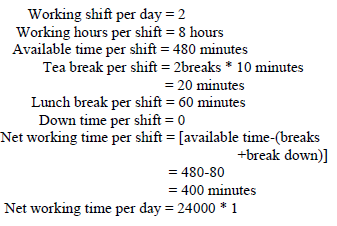 |
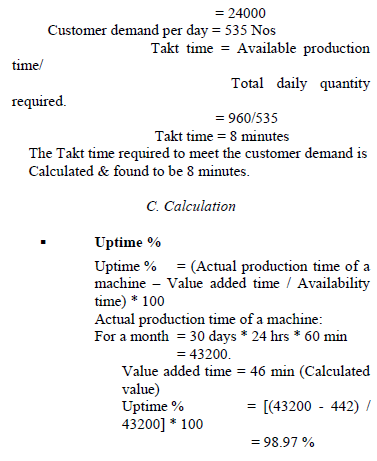 |
| C. Current State Map The production control information flow is shown to determine how the production processes are being scheduled and controlled. At the bottom of the Map, the total process time and lead time are calculated for a typical product family unit or order. |
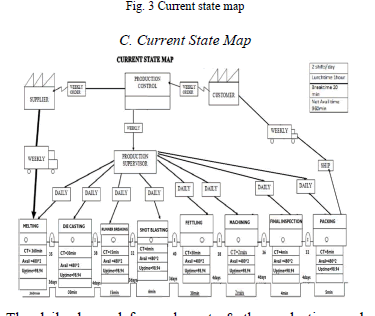 |
| The daily demand for each parts & the cycle time and number of operators for every machine are noted. Then the productions of each machine are calculated. These are tabulated in fig.3 |
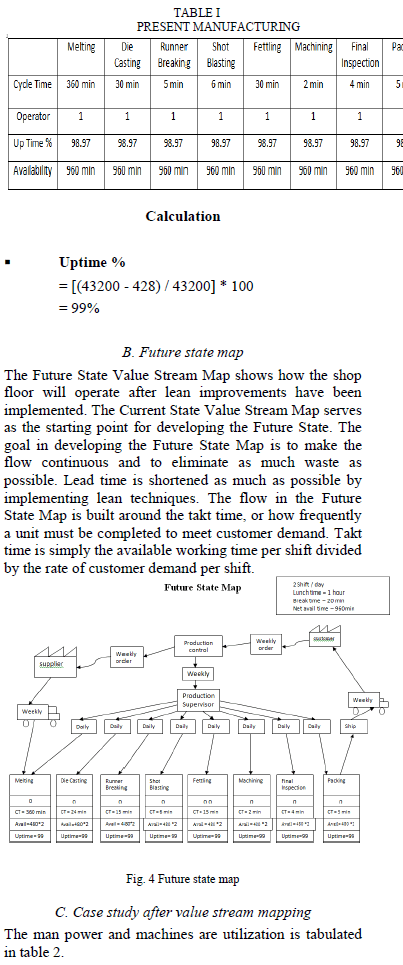 |
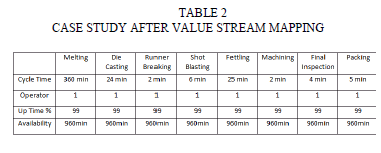 |
X. CONCLUSION |
| This paper delivers the evidence of valid advantage when applying lean principle to the Shopfloor. By applying 5s technique resulting effective organization of the workplace, reduction of work‘s environment, elimination of losses connected with failures and breaks, improvement of the quality and Safety of work. From VSM to remove the non-Valued activities during manufacturing and also to reduce manufacturing lead time. The Proposed process will overcome the drawbacks of the existing process with complete functionalities and quick respond time. This Process will be very effective and we hope that they will implement in future. |
References |
|